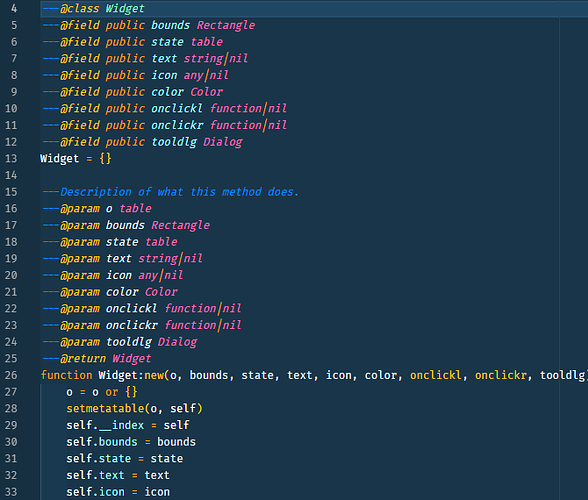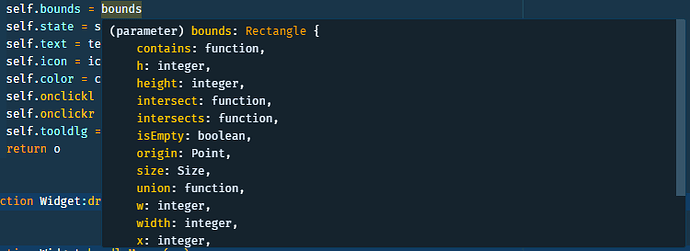Hello and thank you in advance for your time and help.
I try to rewrite my tool ring script so it can be modified more easily I got most of it working but I can’t get to make it happen that each tool widget is displayed in it’s own dialog, instead all widgets show in the first created dialog.
local mouse = {position = Point(0, 0), leftClick = false}
local focusedWidget = nil
-- Define the Widget class
Widget = {bounds = nil, state = nil, text = nil, icon = nil, onclickl = nil, onclickr = nil, tooldlg = nil}
function Widget:new(o, bounds, state, text, icon, color, onclickl, onclickr, tooldlg)
o = o or {}
setmetatable(o, self)
self.__index = self
self.bounds = bounds
self.state = state
self.text = text
self.icon = icon
self.color = color
self.onclickl = onclickl
self.onclickr = onclickr
self.tooldlg = tooldlg
return o
end
function Widget:draw(ctx)
local state = self.state.normal
if self == focusedWidget then
state = self.state.focused
end
local isMouseOver = self.bounds:contains(mouse.position)
if isMouseOver then
state = self.state.hot or state
if mouse.leftClick then
state = self.state.selected
end
end
ctx:drawThemeRect(state.part, self.bounds)
local center = Point(self.bounds.x + self.bounds.width / 2,
self.bounds.y + self.bounds.height / 2)
if self.icon then
local size = Rectangle(0, 0, 16, 16) -- Assuming default icon size of 16x16 pixels
ctx:drawThemeImage(self.icon, center.x - size.width / 2,
center.y - size.height / 2)
elseif self.text then
local size = ctx:measureText(self.text)
ctx.color = app.theme.color[state.color]
ctx:fillText(self.text, center.x - size.width / 2,
center.y - size.height / 2)
elseif self.color then
local size = self:shrinkSize(self.bounds, 6)
ctx.color = self.color
ctx:roundedRect(size, 8)
ctx:stroke()
ctx:fill()
end
end
function Widget:handleMouse(ev)
local isMouseOver = self.bounds:contains(mouse.position)
if isMouseOver then
if mouse.leftClick then
self.onclickl()
focusedWidget = self
elseif mouse.rightClick then
self.onclickr()
focusedWidget = self
end
end
end
function Widget:shrinkSize(rect, size)
return Rectangle(rect.x + 0.5*size, rect.y + 0.5*size, rect.width - size, rect.height - size)
end
function Widget:show(bounds)
self.tooldlg:show(self.tooldlg.dlg,bounds)
end
function Widget:close()
self.tooldlg:close(self.tooldlg.dlg)
end
-- Define tool dialog class
ToolDialog = {titl = nil, bounds = nil, dlg = nil, canvas = nil}
function ToolDialog:new(o, title, bounds)
o = o or {}
setmetatable(o, self)
self.__index = self
self.title = title
self.bounds = bounds
return o
end
function ToolDialog:show(dlg,bounds)
dlg:show{
wait=false,
bounds=bounds,
autoscrollbars=false,
}
end
function ToolDialog:create(title, bounds, widget)
local dlg = Dialog(title)
--dlg:modify{onclose = function() self:close() end}
self.canvas = dlg:canvas{id = title,
width = bounds.width,
height = bounds.height,
onpaint = function(ev)
local ctx = ev.context
widget:draw(ctx)
end,
onmousemove = function(ev)
mouse.position = Point(ev.x, ev.y)
dlg:repaint()
end,
onmousedown = function(ev)
mouse.leftClick = ev.button == MouseButton.LEFT
mouse.rightClick = ev.button == MouseButton.RIGHT
widget:handleMouse(ev)
dlg:repaint()
end,
onmouseup = function(ev)
if ev.button == MouseButton.LEFT then
mouse.leftClick = false
end
if ev.button == MouseButton.RIGHT then
mouse.rightClick = false
end
dlg:repaint()
end
}
self.dlg = dlg
end
function ToolDialog:close(dlg)
dlg:close()
end
function createTool(o, title, onclickl, onclickr)
-- Create instance of the Tooldialog class
local dlg = ToolDialog:new(nil, title, Rectangle(0,0, BUTTON_SIZE, BUTTON_SIZE))
-- Create instances of the Widget class
local widget = Widget:new(o, Rectangle(0, 0, BUTTON_SIZE, BUTTON_SIZE), {
normal = {part = "button_normal", color = "button_normal_text"},
focused = {part = "button_focused", color = "button_normal_text"},
hot = {part = "button_hot", color = "button_hot_text"},
selected = {part = "button_selected", color = "button_selected_text"},
-- Other states...
}, nil, nil,app.fgColor,nil,nil,dlg )
widget.onclickl = onclickl
widget.onclickr = onclickr
dlg:create(title, dlg.bounds, widget)
return widget
end
--Instantiate Tools
local myTool = {}
myTool = createTool(myTool, "Pick Color", function()app.fgColor = myTool.color end, function() myTool.color = app.fgColor end)
local myOtherTool ={}
myOtherTool = createTool(myOtherTool, "Pick Another Color", function()app.fgColor = myTool.color end, function() myTool.color = app.fgColor end)
myTool:show(Rectangle(500, 100, 180, 140))
myOtherTool:show(Rectangle(300, 80, 80, 80))
I’m not so familiar with LUA so if there are other improvements that could be also done, I would be happy for any feedback.

